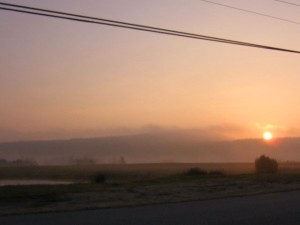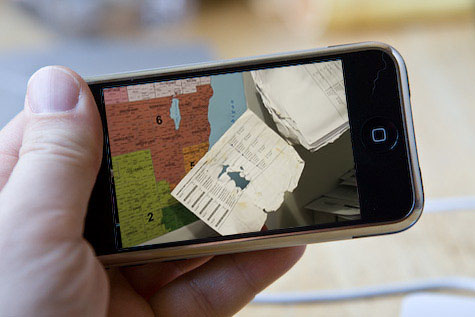 The morning of November 4, 2008 found me — like thousands of others all across the nation — rushing from door to door the final phase of the get-out-the-vote (GOTV) effort. In those pre-dawn hours in rural New Hampshire, the fate of the election came down to the mundane work of footsoldiers armed with low-tech (yet high-gloss) door hangers and paper walksheets.
The morning of November 4, 2008 found me — like thousands of others all across the nation — rushing from door to door the final phase of the get-out-the-vote (GOTV) effort. In those pre-dawn hours in rural New Hampshire, the fate of the election came down to the mundane work of footsoldiers armed with low-tech (yet high-gloss) door hangers and paper walksheets.
 But only this literal last mile was low-tech. Everything leading up to this moment was built on a solid, database-driven foundation. And so it’s easy to imagine how the mechanics of campaigning might evolve over the next four years:
But only this literal last mile was low-tech. Everything leading up to this moment was built on a solid, database-driven foundation. And so it’s easy to imagine how the mechanics of campaigning might evolve over the next four years:
- Cloud campaigning: The weakest chain in the GOTV effort lay between ID’ing supporters and processing that information before the next push. Driving completed walksheets 30 miles to HQ, entering the numbers accurately, and printing it all out again in time for the next day’s walk proved too Herculean for even Obama’s vaunted team. On E-Day, my canvassing list included names I’d identified a few days earlier as non-supporters (though it’s also possible that the campaign used some other logic, like demographics, to put them back on the walk list). Web-enabled smartphones like the iPhone can change all of this. Just as MyBO enabled supporters to call voters from the comfort of home, so too will the walklist of the future stream straight to your phone as you go door to door, with results beaming directly back into the central database. In four years, cell phone data services might be robust enough to do this in rural Iowa as well as downtown Philly.
- Canvassing, the RTS: Back in January, I hung out with Voter File Manager for the SC primaries Kyle Cox and watched the data sausage get made. One of our side projects was setting up GIS maps for the E-Day boiler room. The maps were, I’m told, a success — one of our field organizer friends later marveled at their ability to see numbers pop as a result of redeploying canvassing teams from over-performing to under-performing precincts. For the general election, Project Houdini turned the voting data live (it “disappeared” the already-voted off canvassing lists). For now, the Houdini system relies on human poll watchers to telegraph names to HQ. (Back in January, at the staging location we ran we did this same work by hand, crossing names off canvassing lists after we’d gotten word that they’d voted). In four years, I’m expecting campaign boiler rooms to also feature live dots showing exactly where all the “troops” are, too, just by tracking the location of the phones in their pockets. It will be every strategy gamer’s dream come true.
- Advanced data mining: Once data can be captured live, incredibly rich data mining becomes possible. That an undecided voter worries most about health insurance is incredibly valuable for future persuasion efforts. So, too, is the fact that she is home at 3pm on a Wednesday — something that can be gleaned from live data updates. (Surely this same data is already being harvested out of MyBO calls). This DKos diarist’s joke about how much the Obama campaign knew about voters may not one day be that far from reality.
 Of course, with any change comes risk, and technology for technology’s sake is a dangerous temptation. Project Houdini was a huge advance over the paper-based system we used during the primary, but it requires a huge amount of manpower that may not be available to every campaign (indeed, it wasn’t deployed across the map in the Obama campaign on Tuesday, either). Here are a few concerns that data jocks should watch out for moving forward:
Of course, with any change comes risk, and technology for technology’s sake is a dangerous temptation. Project Houdini was a huge advance over the paper-based system we used during the primary, but it requires a huge amount of manpower that may not be available to every campaign (indeed, it wasn’t deployed across the map in the Obama campaign on Tuesday, either). Here are a few concerns that data jocks should watch out for moving forward:
- Data integrity: Apparently both the McCain and Obama campaigns’ databases were compromised, perhaps by foreign agents. And rumor had it that the competing campaigns in the primary muddied competitors’ supporter data, leading to total segregation of the database by candidate. But it doesn’t take ill intent to screw up data, just sloppiness.
- Naive rules: Data mining requires not just good data, but smart rules to make sense of the numbers. What happened to Wall Street quants around exotic derivatives can easily happen to campaigns, too: bad assumptions can add up to bad performance. Maybe it makes sense to target older, presumably retired, voters mid-day and the younger ones very early or in the late afternoon. But what if, in one particular area, the older folks are still employed, or the younger ones work from home? Sometimes, the best methods might be the dumber ones.
- Training the soldiers: Garbage in, garbage out still applies. All the data in the world don’t change the fact that canvassers are out in the neighborhood to make human contact and to persuade voters over to their side. Canvassers need to learn the skills needed to do that well. And after persuading a voter, they also need to know how to code them — a “2 – Lean” for one canvasser might look like a “3 – Undecided” to another. Data are only useful when they’re reliable, and that depends on a fairly precise measuring instrument — well-trained volunteers.
Of course, I’m talking here just about campaign technology, not governance. While it’s possible to imagine deploying some variant of this kind of effort to put pressure on Congress to pass health care legislation, most of the day-to-day of democracy works quite differently, and for all of the Obama campaign’s reputation for bottom-up innovation, most of it happened around tactical operations, not strategy, and certainly not policy-making. I’ll have more speculation on that aspect of the future of civic technology later…
(Cross-posted at techPresident).






interesting blog !
nice article 🙂